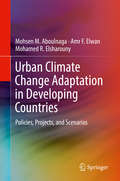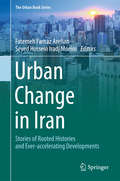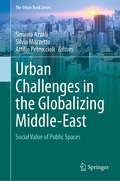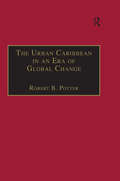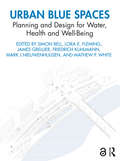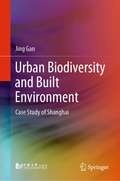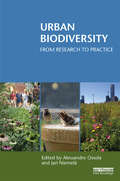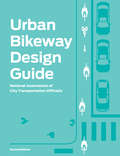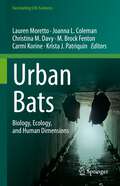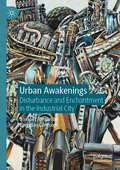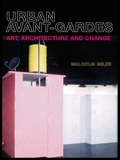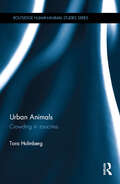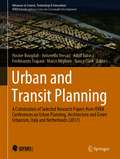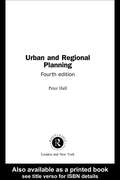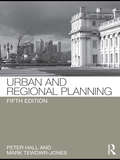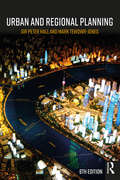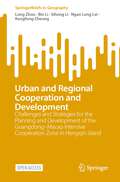- Table View
- List View
Urban Climate Change Adaptation in Developing Countries: Policies, Projects, and Scenarios
by Mohsen M. Aboulnaga Amr F. Elwan Mohamed R. ElsharounyThis book describes the risks, impacts, measures, actions and adaptation policies that have developed globally as a result of the severe impacts of global climate change. In-depth chapters focus on climate change assessment (CCA) in terms of vulnerabilities and reflection on the built environment and measures and actions for infrastructure and urban areas. Adaptation actions specific to developing countries such as Egypt are presented and illustrated. Global Climate change adaptation projects (CCAPs) in developing countries, in terms of their targets and performance, are presented and compared with those existing CCAPs in Egypt to draw learned lessons. Climate change scenarios 2080 using simulations are portrayed and discussed with emphasis on a case-study model from existing social housing projects in hot-arid urban areas in Cairo; in an effort to put forward an assessment and evaluation of current CCA techniques. This book helps researchers realize the global impacts of climate change on the built environment and economic sectors, and enhances their understanding of current climate change measures, actions, policies, projects and scenarios.Reviews and illustrates the impact of global climate change risks;Provides an understanding of global climate change risks in seven continents;Illustrates policies and action plans implemented at the global level and developing countries' level;Discusses climate change assessment and vulnerabilities with emphasis on urban areas;Presents measures and action plans to mitigate climate change scenarios by 2080.
Urban Change in Iran: Stories of Rooted Histories and Ever-accelerating Developments (The Urban Book Series)
by Fatemeh Farnaz Arefian Seyed Hossein Iradj MoeiniThis book, based on conference excerpts, investigates various aspects of contemporary Iranian urbanism. The topics covered range from the impacts of political developments on the cities’ rapid socio-economic developments, to the cities’ troubled relationship with the country’s built-environment history and their frequently ill-managed exposure to Western notions of development and globalisation. Last but not least, the country’s vulnerability to natural disasters in an age of increasing urban-population densification is also considered. Alongside more theoretically and artistically oriented debates, the book’s individual contributions turn their attention to the now much higher proportion of urban dwellers in the country’s rising population. It also discusses the policies designed in response to these demographic moves, including those to develop new towns, find housing for the excess population in existing cities, renovate historic buildings and create new public spaces. The practice-policy oriented contributions also include those concerning the country’s responses to natural disasters.
Urban Challenges in the Globalizing Middle-East: Social Value of Public Spaces (The Urban Book Series)
by Simona Azzali Silvia Mazzetto Attilio PetruccioliThis publication aims to investigate the nature of social life in public and urban spaces in the cities of the Middle East, considering the value of environmental approaches. It aims to develop a better understanding of the patterns of social interactions and activities in public places, which have been influenced by cultural heritage values.Sustainable and livable open spaces can help in improving living conditions in cities. Public spaces are relevant as they satisfy many human needs. In public spaces, people interact and meet; people with different cultures and social backgrounds can communicate and learn from each other in social and spontaneous ways. However, decision-makers tend to forget the value of public spaces, especially in the absence of a national regulatory framework in emerging globalized cities.The book provides a multi-disciplinary approach in reading the characteristics and values of public spaces in the emerging cities of the Middle East.
The Urban Caribbean in an Era of Global Change
by Robert B. PotterBased on the author’s first hand field research, this book addresses the twin processes of urbanization and globalization as they affect the contemporary Caribbean region. One of the key aims of the book is to focus attention on the fact that contrary to popular perceptions, the Caribbean is highly urbanized. Indeed statistics show that the region is more highly urbanized than the world taken as a whole. In addition, the fact that the Caribbean region has always been affected by processes of globalization, in respect of its economy, polity and society, is central to the text. The chapters cover pressing topics such as urban change and the evolution of mini-metropolitan regions, the importance of the mercantile and plantopolis frameworks, tourism, post modernity and the urban nexus, economic change and the dual processes of global convergence and divergence, and the nature of the relationships existing between the state, the informal sector, housing and environmental conditions. In reality, it is shown that the development of tourism and enclave manufacturing is leading to new forms of urban concentration, and not spatial dispersal.
The Urban Caribbean in an Era of Global Change
by Robert B. PotterBased on the author’s first hand field research, this book addresses the twin processes of urbanization and globalization as they affect the contemporary Caribbean region. One of the key aims of the book is to focus attention on the fact that contrary to popular perceptions, the Caribbean is highly urbanized. Indeed statistics show that the region is more highly urbanized than the world taken as a whole. In addition, the fact that the Caribbean region has always been affected by processes of globalization, in respect of its economy, polity and society, is central to the text. The chapters cover pressing topics such as urban change and the evolution of mini-metropolitan regions, the importance of the mercantile and plantopolis frameworks, tourism, post modernity and the urban nexus, economic change and the dual processes of global convergence and divergence, and the nature of the relationships existing between the state, the informal sector, housing and environmental conditions. In reality, it is shown that the development of tourism and enclave manufacturing is leading to new forms of urban concentration, and not spatial dispersal.
Urban Blue Spaces: Planning and Design for Water, Health and Well-Being
by Simon Bell Lora E. Fleming James Grellier Friedrich Kuhlmann Mark J. Nieuwenhuijsen Mathew P. WhiteThis book presents an evidence-based approach to landscape planning and design for urban blue spaces that maximises the benefits to human health and well-being while minimising the risks. Based on applied research and evidence from primary and secondary data sources stemming from the EU-funded BlueHealth project, the book presents nature-based solutions to promote sustainable and resilient cities. Numerous cities around the world are located alongside bodies of water in the form of coastlines, lakes, rivers and canals, but the relationship between city inhabitants and these water sources has often been ambivalent. In many cities, water has been polluted, engineered or ignored completely. But, due to an increasing awareness of the strong connections between city, people, nature and water and health, this paradigm is shifting. The international editorial team, consisting of researchers and professionals across several disciplines, leads the reader through theoretical aspects, evidence, illustrated case studies, risk assessment and a series of validated tools to aid planning and design before finishing with overarching planning and design principles for a range of blue-space types. Over 200 full-colour illustrations accompany the case-study examples from geographic locations all over the world, including Portugal, the United Kingdom, China, Canada, the US, South Korea, Singapore, Norway and Estonia. With green and blue infrastructure now at the forefront of current policies and trends to promote healthy, sustainable cities, Urban Blue Spaces is a must-have for professionals and students in landscape planning, urban design and environmental design. Open Access for the book was funded by the European Union's Horizon 2020 research and innovation programme under grant agreement No 666773
Urban Blue Spaces: Planning and Design for Water, Health and Well-Being
by Simon Bell Friedrich Kuhlmann Mathew P. White Mark J. Nieuwenhuijsen James Grellier Lora E. FlemingThis book presents an evidence-based approach to landscape planning and design for urban blue spaces that maximises the benefits to human health and well-being while minimising the risks. Based on applied research and evidence from primary and secondary data sources stemming from the EU-funded BlueHealth project, the book presents nature-based solutions to promote sustainable and resilient cities. Numerous cities around the world are located alongside bodies of water in the form of coastlines, lakes, rivers and canals, but the relationship between city inhabitants and these water sources has often been ambivalent. In many cities, water has been polluted, engineered or ignored completely. But, due to an increasing awareness of the strong connections between city, people, nature and water and health, this paradigm is shifting. The international editorial team, consisting of researchers and professionals across several disciplines, leads the reader through theoretical aspects, evidence, illustrated case studies, risk assessment and a series of validated tools to aid planning and design before finishing with overarching planning and design principles for a range of blue-space types. Over 200 full-colour illustrations accompany the case-study examples from geographic locations all over the world, including Portugal, the United Kingdom, China, Canada, the US, South Korea, Singapore, Norway and Estonia. With green and blue infrastructure now at the forefront of current policies and trends to promote healthy, sustainable cities, Urban Blue Spaces is a must-have for professionals and students in landscape planning, urban design and environmental design. Open Access for the book was funded by the European Union's Horizon 2020 research and innovation programme under grant agreement No 666773
Urban Biodiversity and Built Environment: Case Study of Shanghai
by Jing GanThis book proposes the concept of urban multiple habitats and then analyzes its corresponding classification, function and potential supply capability. It provides an analysis framework for studying the relationship between urban biodiversity and built environment, and for considering the loss of urban habitats caused by high-density development. It argues that urban biodiversity is a key indicator for assessing urban ecosystem services. On this basis, the book then presents a case study mainly focusing on wild birds in Shanghai, as urban wild birds and their species could be viewed as an essential indicator for evaluating healthy ecosystem of contemporary cities. Based on the empirical findings, the book proposes an assessment model for urban biodiversity performance and a range of principles, strategies and key indicators regarding the optimization of urban planning and design practice to enhance urban biodiversity performance.
Urban Biodiversity: From Research to Practice (Routledge Studies in Urban Ecology)
by Alessandro Ossola Jari NiemeläUrban biodiversity is an increasingly popular topic among researchers. Worldwide, thousands of research projects are unravelling how urbanisation impacts the biodiversity of cities and towns, as well as its benefits for people and the environment through ecosystem services. Exciting scientific discoveries are made on a daily basis. However, researchers often lack time and opportunity to communicate these findings to the community and those in charge of managing, planning and designing for urban biodiversity. On the other hand, urban practitioners frequently ask researchers for more comprehensible information and actionable tools to guide their actions. This book is designed to fill this cultural and communicative gap by discussing a selection of topics related to urban biodiversity, as well as its benefits for people and the urban environment. It provides an interdisciplinary overview of scientifically grounded knowledge vital for current and future practitioners in charge of urban biodiversity management, its conservation and integration into urban planning. Topics covered include pests and invasive species, rewilding habitats, the contribution of a diverse urban agriculture to food production, implications for human well-being, and how to engage the public with urban conservation strategies. For the first time, world-leading researchers from five continents convene to offer a global interdisciplinary perspective on urban biodiversity narrated with a simple but rigorous language. This book synthesizes research at a level suitable for both students and professionals working in nature conservation and urban planning and management.
Urban Biodiversity: From Research to Practice (Routledge Studies in Urban Ecology)
by Alessandro Ossola Jari NiemeläUrban biodiversity is an increasingly popular topic among researchers. Worldwide, thousands of research projects are unravelling how urbanisation impacts the biodiversity of cities and towns, as well as its benefits for people and the environment through ecosystem services. Exciting scientific discoveries are made on a daily basis. However, researchers often lack time and opportunity to communicate these findings to the community and those in charge of managing, planning and designing for urban biodiversity. On the other hand, urban practitioners frequently ask researchers for more comprehensible information and actionable tools to guide their actions. This book is designed to fill this cultural and communicative gap by discussing a selection of topics related to urban biodiversity, as well as its benefits for people and the urban environment. It provides an interdisciplinary overview of scientifically grounded knowledge vital for current and future practitioners in charge of urban biodiversity management, its conservation and integration into urban planning. Topics covered include pests and invasive species, rewilding habitats, the contribution of a diverse urban agriculture to food production, implications for human well-being, and how to engage the public with urban conservation strategies. For the first time, world-leading researchers from five continents convene to offer a global interdisciplinary perspective on urban biodiversity narrated with a simple but rigorous language. This book synthesizes research at a level suitable for both students and professionals working in nature conservation and urban planning and management.
Urban Bikeway Design Guide
by Natl Assoc of City Transportation ONACTO’s Urban Bikeway Design Guide quickly emerged as the preeminent resource for designing safe, protected bikeways in cities across the United States. It has been completely re-designed with an even more accessible layout. The Guide offers updated graphic profiles for all of its bicycle facilities, a subsection on bicycle boulevard planning and design, and a survey of materials used for green color in bikeways. The Guide continues to build upon the fast-changing state of the practice at the local level. It responds to and accelerates innovative street design and practice around the nation.
Urban Bats: Biology, Ecology, and Human Dimensions (Fascinating Life Sciences)
by Lauren Moretto Joanna L. Coleman Christina M. Davy M. Brock Fenton Carmi Korine Krista J. PatriquinThe Anthropocene is the “age of human influence”, an epoch well known for its urban impact. More than half of all people already live in cities, and this proportion is expected to rise to almost 70 percent by 2050. Like other species in urban areas, bats must contend with the pressures of profound and irreversible land cover change and overcome certain unique challenges, such as the high density of roads, lights, glass, and free-ranging domestic animals. Research on urban bats in recent decades indicates that when it comes to urban life, some bats are synanthropes. In other words, although most species of bats are negatively impacted by urbanisation, many appear to not only succeed, but also thrive in cities and towns. This observation has inspired interesting questions about bats in relation to urbanisation. Which traits and behaviours equip bats for urban success? What features of urban areas increase the likelihood that bats will successfully persist there or even colonize new areas? And how does the success of urban bats affect co-habiting humans?Our book explores the interactions between bats and urban environments through case studies and reviews. Understanding how different species interact with urban environments can reveal potential opportunities to mitigate urban threats to bats and threats posed by bats to other urban organisms, including humans. With this book, we thus aspire to provide a knowledge base to help guide current and future efforts to conserve bats.
Urban Awakenings: Disturbance and Enchantment in the Industrial City
by Samuel Alexander Brendan GleesonThis book presents a series of urban investigations undertaken in the metropolis of Melbourne. It is based on the idea that ‘enchantment’ as an affective state is important to ethical and political engagement. Alexander and Gleeson argue that a sense of enchantment can give people the impulse to care and engage in an increasingly troubled world, whereas disenchantment can lead to resignation. Applying and extending this theory to the urban landscape, the authors walk their home city with eyes open to the possibility of seeing and experiencing the industrial city in different ways. This unique methodology, described as ‘urban tramping’, positions the authors as freethinking freewalkers of the city, encumbered only with the duty to look through the delusions of industrial capitalism towards its troubled, contradictory soul. These urban investigations were disrupted midway by COVID-19, a plague that ended up confirming the book’s central thesis of a fractured modernity vulnerable to various internal contradictions.
Urban Avant-Gardes: Art, Architecture and Change
by Malcolm MilesUrban Avant-Gardes presents original research on a range of recent contemporary practices in and between art and architecture giving perspectives from a wide range of disciplines in the arts, humanities and social sciences that are seldom juxtaposed, it questions many assumptions and accepted positions. This book looks back to past avant-gardes from the nineteenth and twentieth centuries examining the theoretical and critical terrain around avant-garde cultural interventions, and profiles a range of contemporary cases of radical cultural practices. The author brings together material from a wide range of disciplines to argue for cultural intervention as a means to radical change, while recognizing that most such efforts in the past have not delivered the dreams of their perpetrators. Distinctive in that it places works of the imagination in the political and cultural context of environmentalism, this book asks how cultural work might contribute to radical social change. It is equally concerned with theory and practice - part one providing a theoretical framework and part two illustrating such frameworks with examples.
Urban Avant-Gardes: Art, Architecture and Change
by Malcolm MilesUrban Avant-Gardes presents original research on a range of recent contemporary practices in and between art and architecture giving perspectives from a wide range of disciplines in the arts, humanities and social sciences that are seldom juxtaposed, it questions many assumptions and accepted positions. This book looks back to past avant-gardes from the nineteenth and twentieth centuries examining the theoretical and critical terrain around avant-garde cultural interventions, and profiles a range of contemporary cases of radical cultural practices. The author brings together material from a wide range of disciplines to argue for cultural intervention as a means to radical change, while recognizing that most such efforts in the past have not delivered the dreams of their perpetrators. Distinctive in that it places works of the imagination in the political and cultural context of environmentalism, this book asks how cultural work might contribute to radical social change. It is equally concerned with theory and practice - part one providing a theoretical framework and part two illustrating such frameworks with examples.
Urban Animals: Crowding in zoocities (Routledge Human-Animal Studies Series)
by Tora HolmbergThe city includes opportunities as well as constraints for humans and other animals alike. Urban animals are often subjected to complaints; they transgress geographical, legal as and cultural ordering systems, while roaming the city in what is often perceived as uncontrolled ways. But they are also objects of care, conservation practices and bio-political interventions. What then, are the "more-than-human" experiences of living in a city? What does it mean to consider spatial formations and urban politics from the perspective of human/animal relations?This book draws on a number of case studies to explore urban controversies around human/animal relations, in particular companion animals: free ranging dogs, homeless and feral cats, urban animal hoarding and "crazy cat ladies". The book explores ‘zoocities’, the theoretical framework in which animal studies meet urban studies, resulting in a reframing of urban relations and space. Through the expansion of urban theories beyond the human, and the resuscitation of sociological theories through animal studies literature, the book seeks to uncover the phenomenon of ‘humanimal crowding’, both as threats to be policed, and as potentially subversive. In this book, a number of urban controversies and crowding technologies are analysed, finally pointing at alternative modes of trans-species urban politics through the promises of humanimal crowding - of proximity and collective agency. The exclusion of animals may be an urban ideology, aiming at social order, but close attention to the level of practice reveals a much more diverse, disordered, and perhaps disturbing experience.
Urban Animals: Crowding in zoocities (Routledge Human-Animal Studies Series)
by Tora HolmbergThe city includes opportunities as well as constraints for humans and other animals alike. Urban animals are often subjected to complaints; they transgress geographical, legal as and cultural ordering systems, while roaming the city in what is often perceived as uncontrolled ways. But they are also objects of care, conservation practices and bio-political interventions. What then, are the "more-than-human" experiences of living in a city? What does it mean to consider spatial formations and urban politics from the perspective of human/animal relations?This book draws on a number of case studies to explore urban controversies around human/animal relations, in particular companion animals: free ranging dogs, homeless and feral cats, urban animal hoarding and "crazy cat ladies". The book explores ‘zoocities’, the theoretical framework in which animal studies meet urban studies, resulting in a reframing of urban relations and space. Through the expansion of urban theories beyond the human, and the resuscitation of sociological theories through animal studies literature, the book seeks to uncover the phenomenon of ‘humanimal crowding’, both as threats to be policed, and as potentially subversive. In this book, a number of urban controversies and crowding technologies are analysed, finally pointing at alternative modes of trans-species urban politics through the promises of humanimal crowding - of proximity and collective agency. The exclusion of animals may be an urban ideology, aiming at social order, but close attention to the level of practice reveals a much more diverse, disordered, and perhaps disturbing experience.
Urban and Transit Planning: A Culmination of Selected Research Papers from IEREK Conferences on Urban Planning, Architecture and Green Urbanism, Italy and Netherlands (2017) (Advances in Science, Technology & Innovation)
by Nancy Clark Hocine Bougdah Antonella Versaci Adolf Sotoca Ferdinando Trapani Marco MiglioreA volume of five parts, this book is a culmination of selected research papers from the second version of the international conferences on Urban Planning & Architectural Design for sustainable Development (UPADSD) and Urban Transit and Sustainable Networks (UTSN) of 2017 in Palermo and the first of the Resilient and Responsible Architecture and Urbanism Conference (RRAU) of 2018 in the Netherlands. This book, not only discusses environmental challenges of the world today, but also informs the reader of the new technologies, tools, and approaches used today for successful planning and development as well as new and upcoming ones. Chapters of this book provide in-depth debates on fields of environmental planning and management, transportation planning, renewable energy generation and sustainable urban land use. It addresses long-term issues as well as short-term issues of land use and transportation in different parts of the world in hopes of improving the quality of life. Topics within this book include: (1) Sustainability and the Built Environment (2) Urban and Environmental Planning (3) Sustainable Urban Land Use and Transportation (4) Energy Efficient Urban Areas & Renewable Energy Generation (5) Quality of Life & Environmental Management Systems. This book is a useful source for academics, researchers and practitioners seeking pioneering research in the field.
Urban and Regional Planning (PDF)
by Peter HallThis is the fourth edition of the classic text for students of urban and regional planning. It gives a historical overview of the developments and changes in the theory and practice of planning, throughout the entiretwentieth century.This extensively revised edition follows the successful format of previous editions. Specific reference is made to the most important British developments in recent times, including the devolution of Scotland, Wales and Northern Ireland, the establishment of the Mayor of London and the dominant urban sustainability paradigm.Planning in Western Europe, since 1945, now incorporates new material on EU-wide issues as well as updated country specific sections. Planning in the United States since 1945, now discusses the continuing trends of urban dispersal and social polarisation, as well as initiatives in land use planning and transportation policies.The book looks at the nature of the planning process at the end of the twentieth century and looks forward to the twenty-first century.
Urban and Regional Planning
by Peter HallThis is the fourth edition of the classic text for students of urban and regional planning. It gives a historical overview of the developments and changes in the theory and practice of planning, throughout the entiretwentieth century.This extensively revised edition follows the successful format of previous editions. Specific reference is made to the most important British developments in recent times, including the devolution of Scotland, Wales and Northern Ireland, the establishment of the Mayor of London and the dominant urban sustainability paradigm.Planning in Western Europe, since 1945, now incorporates new material on EU-wide issues as well as updated country specific sections. Planning in the United States since 1945, now discusses the continuing trends of urban dispersal and social polarisation, as well as initiatives in land use planning and transportation policies.The book looks at the nature of the planning process at the end of the twentieth century and looks forward to the twenty-first century.
Urban and Regional Planning
by Peter Hall Mark Tewdwr-JonesThis is the fifth edition of the classic text for students of urban and regional planning. It gives an historical overview of the developments and changes in the theory and practice of planning, throughout the entire twentieth century. This extensively revised edition follows the successful format of previous editions: it introduces the establishment of planning as part of the public health reforms of the late nineteenth century and goes on to look at the insights of the great figures who influenced the early planning movement, leading up to the creation of the post-war planning machine national and regional planning, and planning for cities and city regions, in the UK, from 1945 to 2010, is then considered. Specific reference is made to the most important British developments in recent times, including the Single Regeneration Budget, English Partnerships, the devolution of Scotland, Wales and Northern Ireland, the establishment of the Mayor of London and the dominant urban sustainability paradigm planning in Western Europe, since 1945, now incorporating new material on EU-wide issues, as well as updated country specific sections planning in the United States, since 1945, now discussing the continuing trends of urban dispersal and social polarisation, as well as initiatives in land use planning and transportation policies finally the book looks at the nature of the planning process at the start of the twenty-first century, reflecting briefly on shifts in planning paradigms since the 1960s and going on to discuss the main issues of the 1990s and 2000s, including sustainability and social exclusion and looking forward to the twenty-first century.
Urban and Regional Planning
by Peter Hall Mark Tewdwr-JonesThis is the fifth edition of the classic text for students of urban and regional planning. It gives an historical overview of the developments and changes in the theory and practice of planning, throughout the entire twentieth century. This extensively revised edition follows the successful format of previous editions: it introduces the establishment of planning as part of the public health reforms of the late nineteenth century and goes on to look at the insights of the great figures who influenced the early planning movement, leading up to the creation of the post-war planning machine national and regional planning, and planning for cities and city regions, in the UK, from 1945 to 2010, is then considered. Specific reference is made to the most important British developments in recent times, including the Single Regeneration Budget, English Partnerships, the devolution of Scotland, Wales and Northern Ireland, the establishment of the Mayor of London and the dominant urban sustainability paradigm planning in Western Europe, since 1945, now incorporating new material on EU-wide issues, as well as updated country specific sections planning in the United States, since 1945, now discussing the continuing trends of urban dispersal and social polarisation, as well as initiatives in land use planning and transportation policies finally the book looks at the nature of the planning process at the start of the twenty-first century, reflecting briefly on shifts in planning paradigms since the 1960s and going on to discuss the main issues of the 1990s and 2000s, including sustainability and social exclusion and looking forward to the twenty-first century.
Urban and Regional Planning
by Peter Hall Mark Tewdwr-JonesThis is the sixth edition of the classic text for students of urban and regional planning. It gives a historical overview of the developments and changes in the theory and practice of planning throughout the entire 20th and first part of the 21st centuries. The extensively revised edition incorporates the most important developments in recent times: debates on economic rebalancing and national infrastructure including high speed rail, energy, millennium projects, Celtic devolution, European influence, impact of London on nation. A new chapter "Planning for cities and city regions 1990-2017": includes new material on housing, localism, neighbourhood planning, privatisation, city modernism, reform, Devo and city deals and metro mayors. Urban and Regional Planning will be invaluable to undergraduate as well as postgraduate Planning students. It will prove useful in a variety of built environment areas such as Architecture, Landscape Architecture, Urban Design, Real Estate where planning is taught.
Urban and Regional Planning
by Peter Hall Mark Tewdwr-JonesThis is the sixth edition of the classic text for students of urban and regional planning. It gives a historical overview of the developments and changes in the theory and practice of planning throughout the entire 20th and first part of the 21st centuries. The extensively revised edition incorporates the most important developments in recent times: debates on economic rebalancing and national infrastructure including high speed rail, energy, millennium projects, Celtic devolution, European influence, impact of London on nation. A new chapter "Planning for cities and city regions 1990-2017": includes new material on housing, localism, neighbourhood planning, privatisation, city modernism, reform, Devo and city deals and metro mayors. Urban and Regional Planning will be invaluable to undergraduate as well as postgraduate Planning students. It will prove useful in a variety of built environment areas such as Architecture, Landscape Architecture, Urban Design, Real Estate where planning is taught.
Urban and Regional Cooperation and Development: Challenges and Strategies for the Planning and Development of the Guangdong–Macao Intensive Cooperation Zone in Hengqin Island (SpringerBriefs in Geography)
by Long Zhou Bin Li Sihong Li Ngan Leng Lei Kengfong CheongThis is an open access book. This book, first of all, introduces the new unveiled Guangdong-Macao Intensive Cooperation Zone with details as a special mode of the regional collaborative development that is committed to be mutually beneficial to both sides with different political and economic systems. China's central authorities have recently issued a masterplan for constructing the Guangdong-Macao Intensive Cooperation Zone at Hengqin Island in September 2021. As China's first and last European colony and one of China’s two special administrative regions (SARs), Macao has developed the gambling industry seven times larger than that of Las Vegas. However, the problem of the homogeneous industrial structure and the urgent need to promote sustainable economic growth by regional cooperation have been important theoretical and practical issues discussed by scholars and policy-makers. The Guangdong-Macao Intensive Cooperation Zone (ICZ) is managed under special customs supervision between two boarder lines and expected to diversify Macao’s economy. Then, this book dissects the theory of regional synergistic development and its applications in a number of international comparative and cross-interdisciplinary case studies worldwide. Finally, from the perspective of land use, transportation connection, and social service, this book thoroughly explores the challenges and strategies to implement the new cooperation model within the framework of one country, two systems, two customs, and two currencies to achieve a win–win situation using updated first-hand data collected by literature review, case study, field survey, spatial analysis, and interview.
